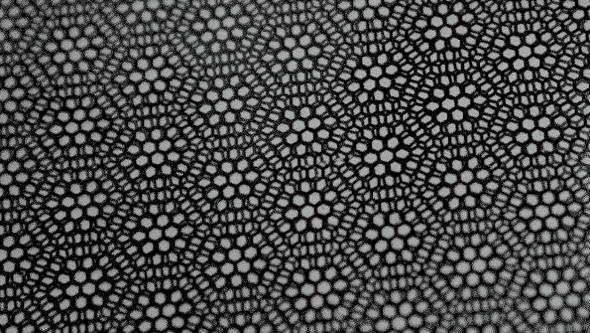Feb 24 2021
Graphene is a two-dimensional material made entirely of carbon. It has exhibited remarkable properties, such as flexibility, transparency, as well as thermal and electrical conductivity.
 Two layers of graphene superimposed at an angle of 1.1° (the so-called “magic angle”) produce a moiré effect. Image Credit: JC Charlier UCLouvain.
Two layers of graphene superimposed at an angle of 1.1° (the so-called “magic angle”) produce a moiré effect. Image Credit: JC Charlier UCLouvain.
Together, such properties turn fascinating, specifically in the age of flexible electronics and touch screens.
Unlike 3D materials, graphene has a height reduced to the ultimate dimension of the atom. It’s therefore a carbon atom plane.
Jean-Christophe Charlier, Professor and Specialist in Nanoscopic Physics, Institute of Condensed Matter and Nanosciences, UCLouvain
In a paper published in the Nature journal, the researcher and his group examined the behavior of electrons when two graphene layers superimposed at an angle of 1.1° (named “magic angle”) produce a moiré effect. This optical effect is quite familiar to fashion specialists, painters, and photographers and includes a figure made of light and dark domains arising through the superposition of two gratings.
When two layers of graphene are superimposed with this magic angle, they give rise to superconductivity. They therefore conduct electricity without any resistance. We've shown that the two graphene planes twisted in this way interact and lead to a restructuring of the atoms into domains where electrons are trapped and localized in space.
Jean-Christophe Charlier, Professor and Specialist in Nanoscopic Physics, Institute of Condensed Matter and Nanosciences, UCLouvain
This property is considered beneficial for transporting electricity without energy loss. But by their very nature, electrons have the tendency to repel each other due to their respective negative charges.
To limit their interactions, the electrons can organize themselves by aligning their spin, which gives them magnetic properties, or by forming an insulator, or by pairing up to produce superconductivity.
Jean-Christophe Charlier, Professor and Specialist in Nanoscopic Physics, Institute of Condensed Matter and Nanosciences, UCLouvain
It is the final one that takes place when it comes to bilayer graphene twisted at the magic angle. Moreover, the researchers have demonstrated that phonons—atom particles that cause vibrations in solid materials—also get trapped in the domains created by the twisted graphene.
The production of new 2D materials and the observation of the remarkable properties that can be achieved with them have resulted in a twistronics craze induced by the concept of being able to make structures with the preferred properties “brick by brick” someday, or to generalize knowledge about simple materials, such as graphene, to more complex materials, enabling improved control or performance of superconducting systems in day-to-day life.
Some examples are the superconducting coils in Japanese magnetic levitation trains (Maglev), which elevate above the rails, or the superconducting magnet used in magnetic resonance imaging (MRI) equipment.
Journal Reference:
Gadelha, A. C., et al. (2021) Localization of lattice dynamics in low-angle twisted bilayer graphene. Nature. doi.org/10.1038/s41586-021-03252-5.